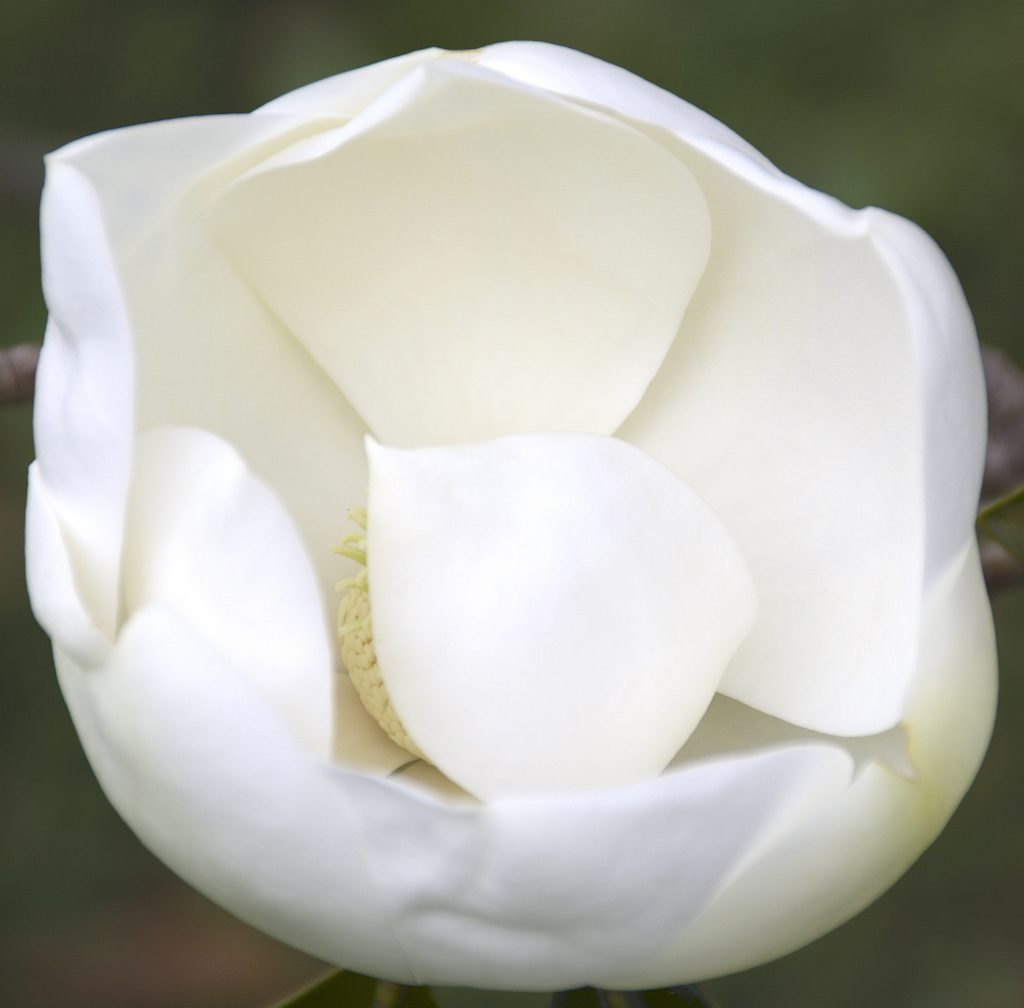
Magnolia grandiflora petals starting to open. Photo by Green Deane
Is it time to rethink Magnolias? The leaves of Magnolia grandiflora can be used like a bay leaf and the blossoms lacto-fermented into a condiment (quite popular in England.) M. grandiflora is not the best leaf in the wild for flavoring, however. That distinction goes to a relative, M. virginana, also known as the Sweet Bay. It’s among the easiest of trees to identify. As I have been making wine lately — see the article below — I pondered making a test gallon of Magnolia Blossom Mead… Magnolia scent and honey… It temps the senses nicely in theory but… The first point is mead. It’s made from honey and takes a long time to ferment. What materials you have in the mead stay in there for a long time. So, if you are going to add cinnamon you only need to add a little because it all gets extracted over time. I am making some Juniper Berry Mead now. Maybe it will be ready next year. Wine can be much different. If you make a fruit wine the fruit is in the “must” for about a week only. It’s an overlay flavor not the total focus. Wine is today, mead is tomorrow. With Magnolia Blossom Mead in mind I picked 580 grams of M. grandiflora blossoms. As I didn’t want them sitting in the mead for months or years I brought them to boil in a gallon of water then let them cool. The resulting tea was exceptionally bitter and vegetative tasting. Not the best candidate for mead or wine. Plan B: Magnolia Blossoms sparingly might be a good hops replacement in making beer and give a nice nose, too. The bitterness of the M. grandiflora raised another possibility: The Sweet Bay blossoms might be a better choice. That is Plan C. I’ll collect some of those blossom and give them a go.
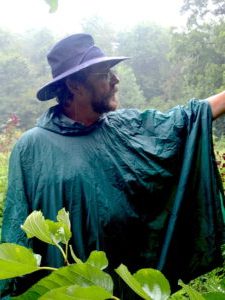
Classes are held rain or shine.
I have two foraging classes this weekend: West Palm Beach and Winter Park near Orlando. One of the things I am curious to see in WPB is where the Jambul Trees are in their fruiting cycle. Fruit trees on the east coast of Florida tend to be four to six weeks behind fruiting trees on the west coast of Florida at the same latitude. The Jambuls were fruiting a few weeks ago in Port Charlotte so they might still be in WPB. There’s about 20 Jambul Trees in Dreher Park. If dropping I will collect a lot. Sunday’s class is in Mead Garden in Winter Park. Because it’s been tended for a century or so there is a density of edible species there. We walk a little, see a lot.
Saturday, July 11th, Dreher Park, 1200 Southern Blvd., West Palm Beach, 33405, 9 a.m. to noon. Meet just north of the science center. This is a 2.5 mile walk over three hours. Plan and dress accordingly.
Sunday, July 12th, Mead Garden: 1500 S. Denning Dr., Winter Park, FL 32789, 9 a.m to noon. Meet in the parking lot near the bathrooms. The entrance to the park is on the west side off Denning Avenue. Many GPS direct you to an old, closed entrance on the east side on S. Pennsylvania Ave.
Saturday, July 18th, Red Bug Slough Preserve, 5200 Beneva Road, Sarasota, FL, 34233. 9 a.m. to noon. We meet at the picnic table by the kids’ play area.
Sunday, July 19th, Boulware Springs Park, 3420 SE 15th St., Gainesville, FL 32641. 9 a.m. to noon. We meet at the picnic table near the spring house. I am presuming the bike area still has Port-o-Lets open.
For more information, to pre-pay for a class, or sign up go here:
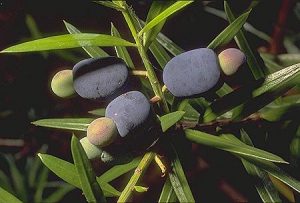
Podocarpus arils are edible. The seeds on the end are not.
Also ripening soon are Podocarpus arils. The Podocarpus is a very common hedge plant which if ignored will grow into a pine-sized tree. The seeds are mildly toxic (and on the end) but the ripe arils are very grape-like and can be used like grapes, eaten off the bush or made into jelly and wine et cetera. The seeds are listed as toxic but I know of an adult who ate two at one time and had no issue. That said, don’t eat the seeds. When the Podocarpus fruits can be something of a guess. Locally I look for them in August but you can find them in July sometimes. The fruit can last several weeks and are edible even when they begin to dry and look like raisins. Oddly, in a local park in downtown Winter Park, a few Podocarpus have escaped trimming and have grown into moderate-size trees. I have seen those fruit in December. You can read more about Podocarpus here.
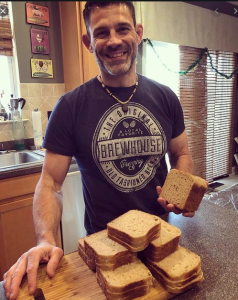
Bill Schindler, ancient food expert
As many of you know the Covid lock up in April resurrected my wine-making habit of decades ago. In fact I bottled 6.5 gallons of Granny Smith Apple Wine this morning. I’ve got Elderberry and Blackberry wine in the making (along with bottled Tangerine Wine, Orange Wine, Lemon Wine, Loquat wine… I should call them my Covid Collection.) I wanted to start a facebook page on fermenting but accidentally made it a page instead of a group. I didn’t know there was a difference until then. So now I have Florida Wine, Bread and Beer group on Facebook (because they all use yeast. I would add lacto-fermentation is welcome as well. I do know something about that.) I also like the anthropological food work of professor Bill Schindler so I expect his work to be sprinkled on the page. His focus is how ancient folks made food edible from plants to animals, essentially pre-agricultural and perhaps the most sapient diet of all. The page is up and populated with recent fermentations: It is Florida Wine, Bread and Beer. Please join if you like.

Green Deane videos are now available on a USB.
Changing foraging videos: As my WordPress pages are being updated the video set will go away. My nine-DVD set of 135 videos has been selling for seven years. They are the same videos I have on You Tube. Some people like to have a separate copy. The DVD format, however, is becoming outdated. Those 135 videos plus 15 more are now available on a 16-gig USB drive. While the videos can be run from the DVDs the videos on the USB have to be copied to your computer to play. They are MP4 files. The150-video USB is $99 and the 135-video DVD set is now $99. The DVDs will be sold until they run out then will be exclusively replaced by the USB. This is a change I’ve been trying to make for several years. So if you have been wanting the 135-video DVD set order it now as the price is reduced and the supply limited. Or you can order the USB. My headache is getting my WordPress Order page changed to reflect these changes. We’ve been working on it for over three weeks. However, if you want to order now either the USB or the DVD set make a $99 “donation” using the link at the bottom of this page or here. That order form provides me with your address, the amount — $99 — tells me it is not a donation and in the note say if you want the DVD set or the USB.

Green Deane Forum
Want to identify a plant? Perhaps you’re looking for a foraging reference? You might have a UFO, an Unidentified Flowering Object, you want identified. On the Green Deane Forum we — including Green Deane and others from around the world — chat about foraging all year. And it’s not just about warm-weather plants or just North American flora. Many nations share common weeds so there’s a lot to talk. There’s also more than weeds. The reference section has information for foraging around the world. There are also articles on food preservation, and forgotten skills from making bows to fermenting food.
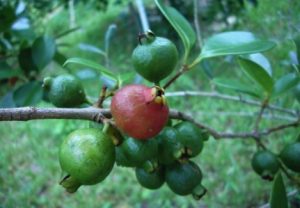
You want pink and green strawberry guava. Photo by Green Deane
Also just beginning to fruit is a species that is very invasive in some areas: The Strawberry Guava. I had one in my yard for about 15 years. Not only are the fruit edible but the dried leaves can be made into a passable tea that also has medicinal qualities. One does, however, need to know a little about the species to make the most of the fruit. It’s a little smaller than a ping-pong ball, has tough seeds, and starts out green and hard. As it ripens and softens it will get shades of pink, yellow and red and eventually become dark red and soft, hence the name “Strawberry Guava.” The fruit is tart and sweet, more tart when young, more sweet when older. Despite the name I never tasted a strawberry flavor in any of the fruit. The problem is unless you spray the tree with insecticides the ripe fruit will be full of fly larvae (which you can also view as free protein.) When the fruit is just starting to turn from green to red the rind is too hard for the flies to lay eggs through. But by the time they are soft and ripe they are prime breeding ground. Thus you have a choice, slightly ripe and tart but bug free, or, very ripe and sweet and squirming. To read more about the Strawberry Guava go here.
This is weekly newsletter 413, If you want to subscribe to this free newsletter you can find the sign-up form in the menu at the top of the page.
To donate to the Green Deane Newsletter click here.

